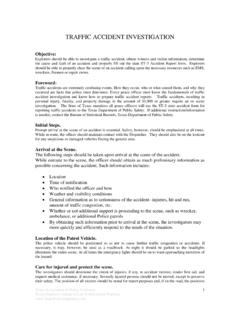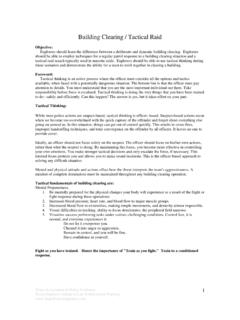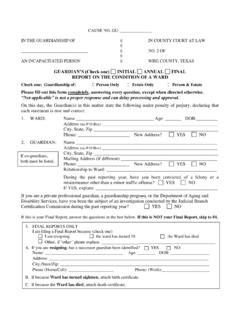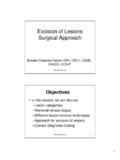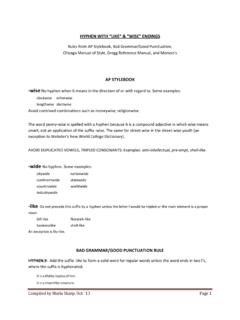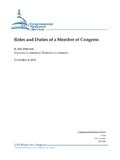Transcription of Use of Force - Concepts - Wise County, Texas
1 Texas Association of Police Explorers Texas Explorer's Guide to Law Enforcement Training 1 Use of Force - Concepts From this lesson the Explorer should have an understanding of the Concepts regarding use of Force . Identify definitions relating to use of Force . Force , the noun, is defined in Webster's as: Strength or energy brought to bear, cause of motion or change, active power; moral or mental strength; capacity to persuade or convince. Violence, compulsion, or constraint exerted upon person or thing. The quality of conveying impressions intensely in writing or speech. Force , the verb, is defined in Webster's as: To do violence to. To compel by physical, moral, or intellectual means. To make or cause through natural or logical necessity. To achieve or win by strength in struggle or violence.
2 An aggressive act committed by any person which does not amount to assault, and is necessary to accomplish an objective. Synonyms - compel, coerce, constrain, oblige. Deadly Force is defined as Force that is intended or known by the actor to cause, or in the manner of its use or intended use is capable of causing, death or serious bodily injury. Reasonable or Necessary Force is the minimum amount of lawful aggression sufficient to achieve a legitimate law enforcement objective. Describe psychological aspects of the use of Force . Law enforcement role in arrest In physical arrest, the police role is essentially defensive. Webster's Dictionary defines the word defensive as "serving to protect", "devoted to resisting or preventing aggression or attack". It is not aggression when an officer takes the initiative to confront a law violator.
3 The officer's act is not one of hostility; it is one designed to defend and protect the community from criminality. Most of an officer's problems grow out of the use of necessary Force employed against a combative but unarmed law violator. An officer needs a range of decision-making tools that permits use of exactly that degree of control which constitutes necessary Force . Concept of Control Control is that degree of influence the officer must exert over the violator to take him or her safely into custody. Control is a "two-way street". An officer must be in complete self-control to be able to control a violator. Self-control alone will be one of the greatest assets in dealing with a law violator. Self-control results from the development of confidence in one's skills.
4 Self-control is achieved through training and practice both on the job and off. The objective of using control is to elicit cooperation from the violator. Some "tools" for the officer to maintain a psychological and physical edge: o Demonstrated alertness. o Be emotionally in control. o Personal appearance and bearing. o If possible, maintain a height advantage. Texas Association of Police Explorers Texas Explorer's Guide to Law Enforcement Training 2 o Triangle interview. (Example: two officers and one suspect). o Be over an arms length from suspect. o Be prepared to step back. o Talking versus fighting. Emotions, Attitudes, Prejudices Arrest can be both an emotional and physical problem for officer and arrestee. Emotional response or reaction is directly involved in an encounter between an officer an a violator.
5 Attitudes or prejudices can lead to conflict. An officer has the potential to reduce the problems and danger associated with physical arrest if s/he is firm but fair with the violator. Emotional responses are often the direct result of uncertainty. Uncertainty is likely to result in compensating behavior. Compensating behavior may take one of the following forms: hesitation, verbal abuse, bluff, unnecessary Force . Identify the deciding factors for use of Force when effecting an arrest. Use of Force Factors In every arrest situation the officers must be firm and be prepared to protect themselves and others. Force must be controlled and used wisely with a purpose. Only the minimum amount of Force necessary to effect the arrest should be used. An officer should consider the following factors when assessing the need to use Force .
6 Is the suspect submitting peacefully or resisting? Is the suspect armed? What is the nature of the crime? Does the suspect have a previous arrest record or history showing a pattern of violence? What is the number of suspects involved? How much support from other officers is available? Identify moral considerations and forces affecting an officer's decision to use deadly Force . Moral Considerations: The law, both statutory and case law. Administrative or Departmental Policy should be at least as restrictive as the law. In many cases it will be more strict than legal restrictions. Informal organizational norms, which reflect law enforcement's informal culture, may or may not be more strict than legal or agency restrictions. Individual choice or conscience reflects the inner controls of the officer.
7 These forces can be depicted by a model of concentric circles. The Explorer should be aware of various Force options or alternatives to increase awareness of various Force options or alternatives available to peace officers. List and discuss Force options available to peace officers. Force Options: Command Presence - entering into a scene with a professional/authoritative appearance and maintaining it. Verbal Communications - words, language. Weaponless Strategies - takedowns, come alongs, etc. Weapon Strategies - Chemical/Electrical Means, mace, stun gun; Baton or Impact Weapons. Deadly Force . Identify the principal considerations in applying a use of Force continuum. Texas Association of Police Explorers Texas Explorer's Guide to Law Enforcement Training 3 There are a number of use of Force continuum scales that various departments have adopted.
8 It is useful to compare and contrast these models. The principle considerations in these scales: Ineffective control results when the level of Force is less than the subject's level of resistance. Excessive control results when the level of Force is unreasonably greater than the subject's level of resistance. The Force used should be no more than a reasonable officer would use under the total circumstances of the situation. Follow departmental policy and the law. (PC Chapter 9) Discuss the impact of an officer's professional presence. Each scene has its own dynamics long before an officer arrives. Events change because of certain kinds of presences. This same type of situation occurs when officers enter the scene; things change. This is due to the officers' presence.
9 Officers must be able to think of the scene as it was before they entered it and what it becomes while they are present. People act differently under different circumstances, and officers' entrances into a scene create new sets of circumstances. Example: You are watching children at play and want to capture the moment on film. When entering the scene with a camera everything changes. The children become self-conscious and pose instead of being themselves. Whatever pictures are taken are different than they would have been had a hidden camera been used. Identify the various aspects of communication strategies used when dealing with the public. Communication is an important professional skill. 97% of an officer's duties involve verbal skills.
10 Only about 3% of contacts require physical Force . Communication process Words, Touch, Body movement, Message; Content - actual message. Voice - verbal personality (how it is said). Non-verbal - raised eyebrows, posture, etc Perception of a message 7% of the time a message is received due to content. 33% of the time a message is received due to voice. 60% of the time a message is received due to non-verbal actions (body language). This means that approximately 93% of the time a message is received and interpreted based on how it is said rather than what is said. Improper listening is not paying attention to what is said, merely waiting for the opportunity to speak as soon as someone finishes talking. Communication is a professional skill, not just luck. Peace officers must communicate under uniquely stressful conditions: To people who do not want to talk, or listen.
